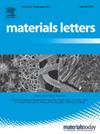探索通过芬顿反应交联的丝-透明质酸水凝胶
IF 2.7
4区 材料科学
Q3 MATERIALS SCIENCE, MULTIDISCIPLINARY
引用次数: 0
摘要
在这里,利用芬顿反应生成了不含 HRP 的丝-HA 混合水凝胶。研究结果表明,在适当的交联密度下,较高的 HA 浓度可通过减少 Fe3+ 离子与蚕丝纤维素的相互作用来增加无规线圈的含量,同时降低 β 片状含量。这有助于形成均匀的水凝胶网络,提高光学透明度。本文介绍的交联策略为制造基于蛋白质或具有酚羟基的聚合物的混合水凝胶支架奠定了基础,无需使用 HRP 催化反应,可广泛应用于生物医学领域。本文章由计算机程序翻译,如有差异,请以英文原文为准。

Exploration of silk-hyaluronic acid hydrogels crosslinked by the Fenton reaction
Herein, HRP-free silk-HA hybrid hydrogels are generated using the Fenton reaction. The findings reveal that a higher HA concentration, at an appropriate crosslinking density, increases the random coil content while decreasing the β-sheet content by reducing the interactions of Fe3+ ions with silk fibroin. This facilitates the formation of homogeneous hydrogel networks with enhanced optical transparency. The crosslinking strategies presented here offer a basis for the fabrication of hybrid hydrogel scaffolds based on proteins or polymers having phenolic hydroxyl moieties, without the use of HRP-catalyzed reactions, for a broad range of biomedical applications.
求助全文
通过发布文献求助,成功后即可免费获取论文全文。
去求助
来源期刊

Materials Letters
工程技术-材料科学:综合
CiteScore
5.60
自引率
3.30%
发文量
1948
审稿时长
50 days
期刊介绍:
Materials Letters has an open access mirror journal Materials Letters: X, sharing the same aims and scope, editorial team, submission system and rigorous peer review.
Materials Letters is dedicated to publishing novel, cutting edge reports of broad interest to the materials community. The journal provides a forum for materials scientists and engineers, physicists, and chemists to rapidly communicate on the most important topics in the field of materials.
Contributions include, but are not limited to, a variety of topics such as:
• Materials - Metals and alloys, amorphous solids, ceramics, composites, polymers, semiconductors
• Applications - Structural, opto-electronic, magnetic, medical, MEMS, sensors, smart
• Characterization - Analytical, microscopy, scanning probes, nanoscopic, optical, electrical, magnetic, acoustic, spectroscopic, diffraction
• Novel Materials - Micro and nanostructures (nanowires, nanotubes, nanoparticles), nanocomposites, thin films, superlattices, quantum dots.
• Processing - Crystal growth, thin film processing, sol-gel processing, mechanical processing, assembly, nanocrystalline processing.
• Properties - Mechanical, magnetic, optical, electrical, ferroelectric, thermal, interfacial, transport, thermodynamic
• Synthesis - Quenching, solid state, solidification, solution synthesis, vapor deposition, high pressure, explosive
 求助内容:
求助内容: 应助结果提醒方式:
应助结果提醒方式:


